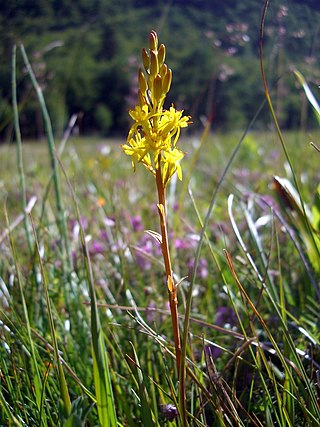
Narthecium is a Eurasian and North American genus of herbaceous flowering plants. This genus was traditionally treated as belonging to the family Liliaceae, but the APG II system of 2003 placed it in the family Nartheciaceae.
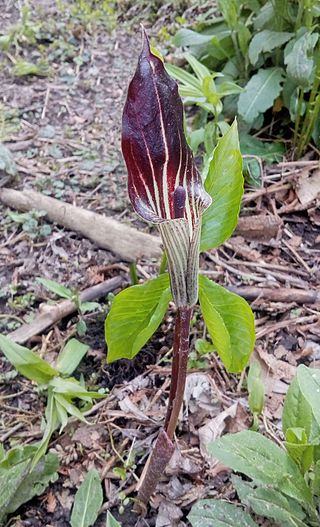
Arisaema triphyllum, the Jack-in-the-pulpit, is a species of flowering plant in the arum family Araceae. It is a member of the Arisaema triphyllum complex, a group of four or five closely-related taxa in eastern North America. The specific name triphyllum means "three-leaved", a characteristic feature of the species, which is also referred to as Indian turnip, bog onion, and brown dragon.

Rubus strigosus, the American red raspberry or American raspberry, is a species of Rubus native to much of North America. It was often treated as a variety or subspecies of the closely related Eurasian Rubus idaeus, but is now more commonly treated as a distinct species. Many of the commercial raspberry cultivars grown for their fruit derive from hybrids between R. strigosus and R. idaeus; see Raspberry for more details.

Tiarella, the foamflowers, is a genus of flowering plants in the family Saxifragaceae. The generic name Tiarella means "little turban", which suggests the shape of the seed capsules. Worldwide there are seven species, one each in eastern Asia and western North America, plus five species in eastern North America. As of October 2022, the taxonomy of Tiarella in eastern North America is in flux.

Ostrya virginiana, the American hophornbeam, is a species of Ostrya native to eastern North America, from Nova Scotia west to southern Manitoba and eastern Wyoming, southeast to northern Florida and southwest to eastern Texas. Populations from Mexico and Central America are also regarded as the same species, although some authors prefer to separate them as a distinct species, Ostrya guatemalensis. Other names include eastern hophornbeam, hardhack, ironwood, and leverwood.
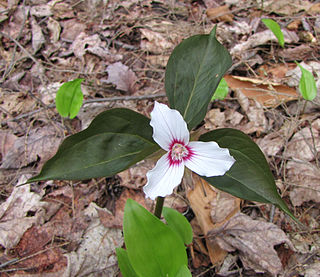
Trillium undulatum, commonly called painted trillium, painted lady, or trille ondulé in French, is a species of flowering plant in the bunchflower family Melanthiaceae. It is also known as smiling wake robin or striped wake-robin. The specific epithet undulatum means "wavy", which refers to the wavy edges of the flower petals. The plant is found from Ontario in the north to northern Georgia in the south and from Michigan in the west to Nova Scotia in the east.

Allium cernuum, known as nodding onion or lady's leek, is a perennial plant in the genus Allium. It grows in open areas in North America.

Moraea, the Cape tulips, is a genus of plants in the family Iridaceae, first described as a genus in 1758. The group is widespread across Africa, the Mediterranean, and central and southwestern Asia. The genus name is a tribute to the English botanist Robert More.

Spiranthes ochroleuca, commonly called the yellow nodding lady's tresses, is a species of orchid occurring from southeastern Canada to the eastern United States.
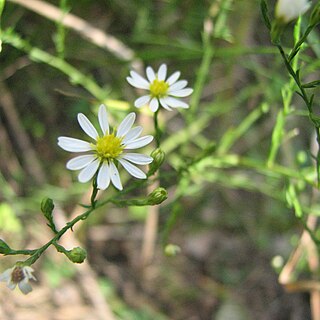
Symphyotrichum depauperatum, commonly known as serpentine aster or starved aster, is a rare species in the family Asteraceae adapted to serpentine barrens, an ecosystem with a high concentration of toxic metals in the soil. It has been found in Pennsylvania, Maryland, and on some diabase glades in North Carolina. It grows to 50 centimeters and has white ray florets surrounding a center of yellow disk florets.
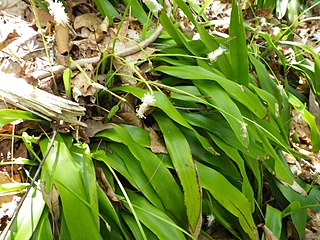
Carex fraseriana is a perennial member of the sedge family with the common name Fraser's sedge. It was the only species of the genus Cymophyllus before it was re-transferred to Carex.
Lily May Perry (1895-1992) was a Canadian-American botanist who worked at Arnold Arboretum and is most known for detailed compilation of information on medicinal plants of East and Southeast Asia and her assistance with the Flora of New Guinea. Perry also has the legacy of authoring the third highest number of land plant species among female scientists, in total naming 414 species.
Malaxis bayardii, or Bayard's adder's-mouth orchid, is a species of orchid native to northeastern North America. It is found from Massachusetts to North Carolina, with isolated populations in Ohio and Nova Scotia. There are historical reports of the plant formerly growing in Vermont and New Jersey, but it seems to have been extirpated in those two states It grows in dry, open woods and pine barrens at elevations of less than 600 m.
Empetrum eamesii, common name purple crowberry, is a plant native to eastern Canada and the northeastern United States. It has been reported from sand dunes, rocky outcrops, and alpine heath in Québec, Nova Scotia, Prince Edward Island, Maine, New Hampshire, Vermont, New York State, the Upper Peninsula of Michigan, Minnesota, Newfoundland & Labrador and St. Pierre & Miquelon.

Najas gracillima, the slender waternymph, is a submerged species of aquatic plant in the Hydrocharitaceae family. found in lakes and streams. It is native to China, Russian Far East, Japan, Korea, Taiwan, Iran, Alberta, Ontario, Newfoundland, Nova Scotia, New Brunswick, the eastern United States. It is also considered introduced and naturalized in France, Spain, Italy and California.
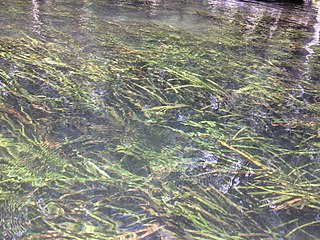
Sagittaria kurziana, common names springtape and strap-leaf sagittaria, is an aquatic plant species native to Florida and naturalized in the Mariana Islands. It grows along large springs, very often those with high sulfur content, and along the banks of watercourses downstream from such springs.

Sagittaria teres, the quill-leaved arrowhead or slender arrowhead, is an aquatic plant species in the genus Sagittaria native to the northeastern United States: Rhode Island, Massachusetts, New Hampshire, New York and New Jersey.

Sagittaria graminea, the grassy arrowhead or grass-leaved arrowhead, is an aquatic plant species native to eastern North America.

Orthochilus ecristatus, or giant orchid, is a terrestrial species of orchid native to Cuba and to the southeastern United States. It was previously known as Eulophia ecristata or Pteroglossaspis ecristata until recently transferred to the genus Orthochilus. This is one of several species known as a "giant orchid".
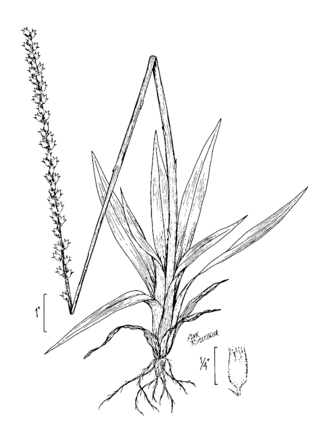
Aletris aurea is a plant species native to the southeastern United States from eastern Texas and southeastern Oklahoma to Maryland.

















